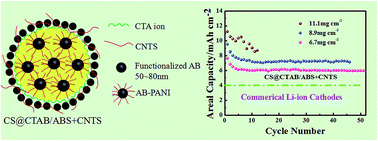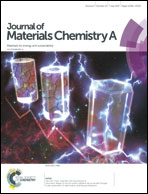Strategies of constructing stable and high sulfur loading cathodes based on the blade-casting technique†
Abstract
Although high energy lithium sulfur (Li–S) battery technology has been vigorously revisited in recent years, the practical application of Li–S batteries is still hindered due to the gap in scientific knowledge between fundamental research and the actual application need. Generally, the sulfur content and sulfur mass loading of sulfur electrodes along with the electrolyte/sulfur ratio are the crucial factors in achieving high-energy-density Li–S batteries. Here, we construct a micro–nano-structured CS@CTAB/ABS + CNTS electrode with a high sulfur content of 76 wt% and a high sulfur mass loading of 6.7–11.1 mg cm−2 for application in Li–S batteries via the blade-casting technique. Benefiting from the unique sulfur composite design, the thick sulfur electrodes demonstrated low polarization, high sulfur utilization and promising electrochemical stability. A high areal capacity of 6.0 mA h cm−2 over 50 cycles was achieved with a sulfur mass loading of 6.7 mg cm−2. And a higher areal capacity of 7.14 mA h cm−2 over 46 cycles could be achieved when the mass loading was increased to 8.9 mg cm−2. Even with a high sulfur mass loading of 11.1 mg cm−2, the sulfur electrode can still deliver a high areal capacity of 11.22 mA h cm−2 at a low electrolyte/sulfur ratio (4 : 1, μl : mg). Hence, this kind of sulfur composite would put forward the possibility of the practical utilization of high-energy-density Li–S batteries.



 Please wait while we load your content...
Please wait while we load your content...